Outline
- 格式:pdf
- 大小:774.07 KB
- 文档页数:70
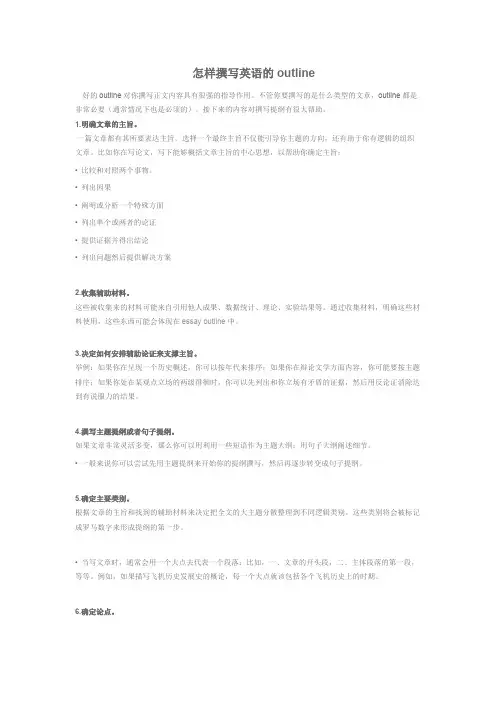
怎样撰写英语的outline好的outline对你撰写正文内容具有很强的指导作用。
不管你要撰写的是什么类型的文章,outline都是非常必要(通常情况下也是必须的)。
接下来的内容对撰写提纲有很大帮助。
1.明确文章的主旨。
一篇文章都有其所要表达主旨。
选择一个最终主旨不仅能引导你主题的方向,还有助于你有逻辑的组织文章。
比如你在写论文,写下能够概括文章主旨的中心思想,以帮助你确定主旨:• 比较和对照两个事物。
• 列出因果• 阐明或分析一个特殊方面• 列出单个或两者的论证• 提供证据并得出结论• 列出问题然后提供解决方案2.收集辅助材料。
这些被收集来的材料可能来自引用他人成果、数据统计、理论、实验结果等。
通过收集材料,明确这些材料使用,这些东西可能会体现在essay outline中。
3.决定如何安排辅助论证来支撑主旨。
举例:如果你在呈现一个历史概述,你可以按年代来排序;如果你在辩论文学方面内容,你可能要按主题排序;如果你处在某观点立场的两级徘徊时,你可以先列出和你立场有矛盾的证据,然后用反论证消除达到有说服力的结果。
4.撰写主题提纲或者句子提纲。
如果文章非常灵活多变,那么你可以用利用一些短语作为主题大纲;用句子大纲阐述细节。
• 一般来说你可以尝试先用主题提纲来开始你的提纲撰写,然后再逐步转变成句子提纲。
5.确定主要类别。
根据文章的主旨和找到的辅助材料来决定把全文的大主题分散整理到不同逻辑类别。
这些类别将会被标记成罗马数字来形成提纲的第一步。
• 当写文章时,通常会用一个大点去代表一个段落:比如,一、文章的开头段,二、主体段落的第一段,等等。
例如,如果描写飞机历史发展史的概论,每一个大点就该包括各个飞机历史上的时期。
6.确定论点。
每个分类至少想两个论点,根据你文章的主旨和你之前收集的论据材料来选择你的分论点。
这些分论点就是你提纲的第二个层级。
一般它们是用英文字母标示的。
(比如A、B、C 等等)• 让你的第二层级比你的第一层级缩进1.27到2.54厘米• 还是用飞机发展史历史的例子,每一个分点就可以描写那个时代的发动机型号7.根据需要确定中心论点的分论点。
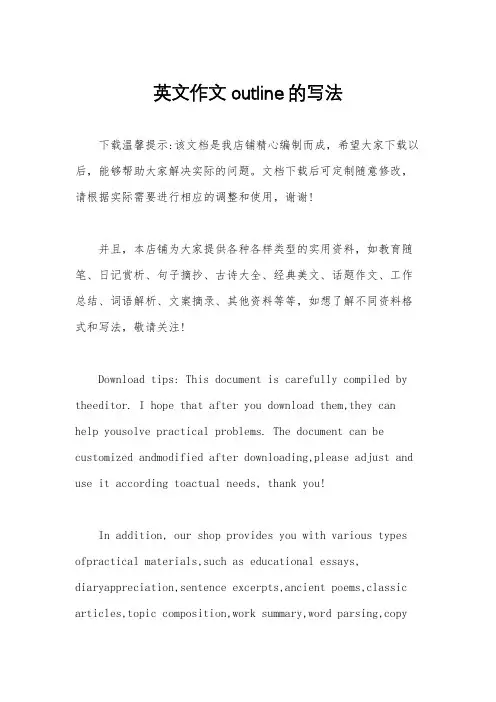
英文作文outline的写法下载温馨提示:该文档是我店铺精心编制而成,希望大家下载以后,能够帮助大家解决实际的问题。
文档下载后可定制随意修改,请根据实际需要进行相应的调整和使用,谢谢!并且,本店铺为大家提供各种各样类型的实用资料,如教育随笔、日记赏析、句子摘抄、古诗大全、经典美文、话题作文、工作总结、词语解析、文案摘录、其他资料等等,如想了解不同资料格式和写法,敬请关注!Download tips: This document is carefully compiled by theeditor. I hope that after you download them,they can help yousolve practical problems. The document can be customized andmodified after downloading,please adjust and use it according toactual needs, thank you!In addition, our shop provides you with various types ofpractical materials,such as educational essays, diaryappreciation,sentence excerpts,ancient poems,classic articles,topic composition,work summary,word parsing,copyexcerpts,other materials and so on,want to know different data formats andwriting methods,please pay attention!Paragraph 1: Well, you know, writing an outline for an English essay can be kind of confusing. There are so many things to think about. Like what to include and what to leave out.Paragraph 2: Another thing is how detailed you want to make it. Do you just list the main points or do you go into a lot of detail? That's a big decision.Paragraph 3: And then there's the style. Do you want it to be formal or more casual? That can really affect the way it comes across.Paragraph 4: Oh, and don't forget about organization. Making sure everything flows nicely and makes sense issuper important.Paragraph 5: Sometimes it's hard to know where to start. But once you get going, it can start to come together.。
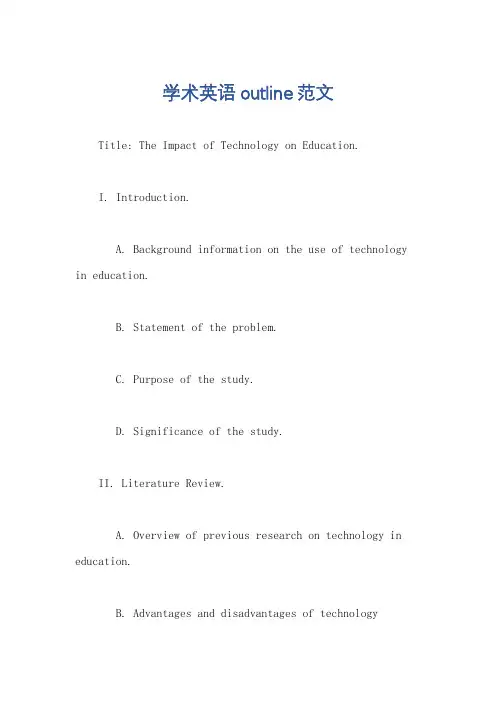
学术英语outline范文Title: The Impact of Technology on Education.I. Introduction.A. Background information on the use of technology in education.B. Statement of the problem.C. Purpose of the study.D. Significance of the study.II. Literature Review.A. Overview of previous research on technology in education.B. Advantages and disadvantages of technologyintegration.C. Current trends in educational technology. III. Methodology.A. Research design.B. Data collection methods.C. Data analysis techniques.IV. Findings.A. Summary of research findings.B. Analysis of data.C. Implications of the findings.V. Discussion.A. Interpretation of the results.B. Comparison of findings with previous research.C. Limitations of the study.VI. Conclusion.A. Summary of the study.B. Recommendations for future research.C. Conclusion statement.VII. References.这个outline范文涵盖了论文的各个部分,包括引言、文献综述、方法论、研究结果、讨论、结论和参考文献。
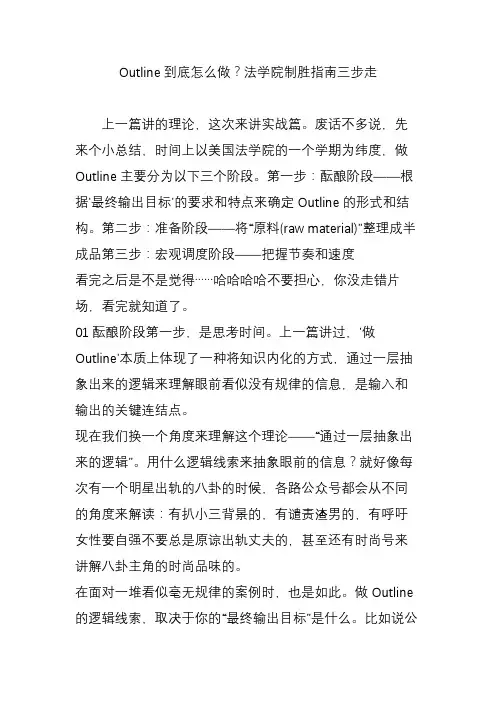
Outline到底怎么做?法学院制胜指南三步走上一篇讲的理论,这次来讲实战篇。
废话不多说,先来个小总结,时间上以美国法学院的一个学期为纬度,做Outline主要分为以下三个阶段。
第一步:酝酿阶段——根据'最终输出目标'的要求和特点来确定Outline的形式和结构。
第二步:准备阶段——将“原料(raw material)”整理成半成品第三步:宏观调度阶段——把握节奏和速度看完之后是不是觉得……哈哈哈哈不要担心,你没走错片场,看完就知道了。
01酝酿阶段第一步,是思考时间。
上一篇讲过,'做Outline'本质上体现了一种将知识内化的方式,通过一层抽象出来的逻辑来理解眼前看似没有规律的信息,是输入和输出的关键连结点。
现在我们换一个角度来理解这个理论——“通过一层抽象出来的逻辑”。
用什么逻辑线索来抽象眼前的信息?就好像每次有一个明星出轨的八卦的时候,各路公众号都会从不同的角度来解读:有扒小三背景的,有谴责渣男的,有呼吁女性要自强不要总是原谅出轨丈夫的,甚至还有时尚号来讲解八卦主角的时尚品味的。
在面对一堆看似毫无规律的案例时,也是如此。
做Outline的逻辑线索,取决于你的“最终输出目标”是什么。
比如说公众号博主们写八卦,想写小三背景的回去翻旧新闻,想写女权主义的则要找负面典型,写时尚品味的要去找人家的私服穿搭照片。
在开始动笔做任何Outline之前,第一步永远是先动脑子想一想——我什么时候要用这份Outline?Outline 要做成什么样子,才能服务于我的最终输出目标?最终输出目标是啥?当然是考试题阿同学们。
但是就像我之前讲的,“做Outline”本质上是一种可以用在任何情景下的学习方式,这篇文章细化到“应付美国法学院的期末考试”这一标准目标,但是背后的指导理念其实是普世而皆准的。
说回到考试题。
美国法学院的考试,有一种很稳定、又十分常见的方式叫'issue spotting',意思就是在考试的时候,给你一个几千个字,案情极为复杂的案例,让你从中找出'issue'——案情争议点,并给予分析。
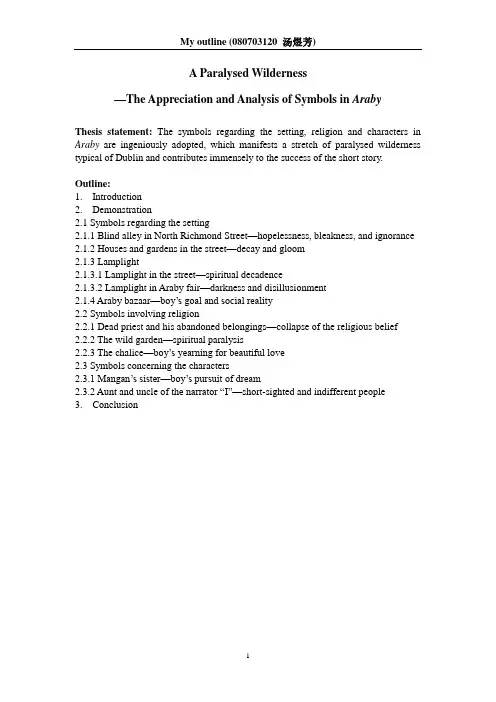
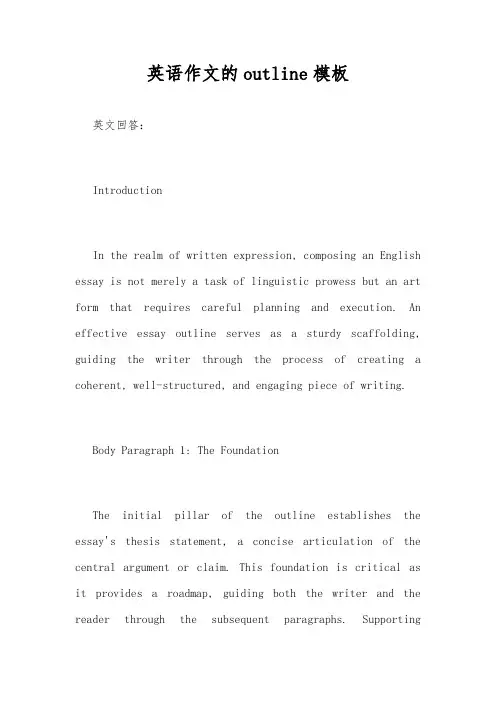
英语作文的outline模板英文回答:IntroductionIn the realm of written expression, composing an English essay is not merely a task of linguistic prowess but an art form that requires careful planning and execution. An effective essay outline serves as a sturdy scaffolding, guiding the writer through the process of creating a coherent, well-structured, and engaging piece of writing.Body Paragraph 1: The FoundationThe initial pillar of the outline establishes the essay's thesis statement, a concise articulation of the central argument or claim. This foundation is critical as it provides a roadmap, guiding both the writer and the reader through the subsequent paragraphs. Supportingevidence, drawn from credible sources or personal anecdotes, anchors the thesis statement, bolstering its credibility and laying the groundwork for the essay's development.Body Paragraph 2: Exploration and AnalysisThe second paragraph delves into the first major point that supports the thesis statement. Here, the writer explores the topic in greater depth, utilizing a variety of perspectives and angles to strengthen the argument. Engaging the reader on an intellectual level, the writer analyzes and discusses the implications of the supporting evidence, building momentum towards the essay's climax.Body Paragraph 3: Expansion and ComplexityThe third paragraph extends the essay's argument by introducing a second major supporting point. This paragraph allows the writer to expand the scope of the discussion, introducing new perspectives or exploring the topic'scomplexities. It serves as a bridge, seamlessly connecting the initial point to the upcoming conclusion.Body Paragraph 4: Transition and ReinforcementThe fourth paragraph transitions smoothly between the two major supporting points. It reinforces the overall argument, weaving together the threads of the preceding paragraphs to create a cohesive narrative. Through the skillful use of transitional devices, the writer maintains the flow of the essay, guiding the reader's understanding effortlessly.ConclusionIn the concluding paragraph, the writer brings the essay to a satisfying close. The thesis statement is revisited, reinforced, and expanded upon. The writer succinctly restates the main points, leaving a lasting impression on the reader's mind. A final thought, a call to action, or apoignant reflection may serve as a thought-provoking finale, inviting contemplation and engagement long after the essay has been read.中文回答:导言在书面表达领域,写好一篇英语作文不仅仅是语言能力的展示,更是一种需要精心规划和执行的艺术形式。
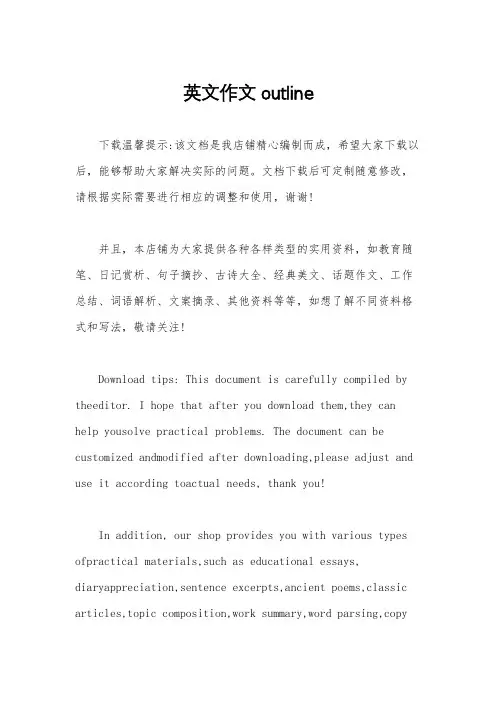
英文作文outline下载温馨提示:该文档是我店铺精心编制而成,希望大家下载以后,能够帮助大家解决实际的问题。
文档下载后可定制随意修改,请根据实际需要进行相应的调整和使用,谢谢!并且,本店铺为大家提供各种各样类型的实用资料,如教育随笔、日记赏析、句子摘抄、古诗大全、经典美文、话题作文、工作总结、词语解析、文案摘录、其他资料等等,如想了解不同资料格式和写法,敬请关注!Download tips: This document is carefully compiled by theeditor. I hope that after you download them,they can help yousolve practical problems. The document can be customized andmodified after downloading,please adjust and use it according toactual needs, thank you!In addition, our shop provides you with various types ofpractical materials,such as educational essays, diaryappreciation,sentence excerpts,ancient poems,classic articles,topic composition,work summary,word parsing,copyexcerpts,other materials and so on,want to know different data formats andwriting methods,please pay attention!Living in a Digital Age。
In today's fast-paced world, technology has become an integral part of our lives. We rely on our smartphones, laptops, and other gadgets to communicate, work, and entertain ourselves. The digital age has brought about many changes in the way we live and interact with others.One of the biggest advantages of living in a digitalage is the convenience it offers. With just a few taps on our smartphones, we can order food, book a ride, or evenpay our bills. Gone are the days when we had to stand in long queues or wait for hours for a response. Everything is just a click away, making our lives much easier and more efficient.However, living in a digital age also has its downsides. With the constant bombardment of information and distractions, it can be difficult to focus and stay present.We are constantly checking our phones, scrolling through social media feeds, and consuming content, often neglecting the real world around us. This constant need forstimulation can lead to feelings of anxiety and disconnection from the present moment.Moreover, the digital age has also given rise to new forms of addiction. People are becoming addicted to social media, online gaming, and even shopping. The instant gratification and rewards provided by these platforms make it hard for individuals to break free from their virtual worlds. This addiction can have serious consequences onone's mental and physical health, as well as their relationships with others.On the other hand, the digital age has also opened up new opportunities for creativity and self-expression. With platforms like YouTube, Instagram, and TikTok, anyone can become a content creator and share their talents with the world. This has democratized the creative industry and given a voice to those who were previously marginalized. People can now showcase their skills, tell their stories,and connect with like-minded individuals from all over the world.In conclusion, living in a digital age has its pros and cons. While it offers convenience and new opportunities, it also presents challenges such as addiction and disconnection from reality. It is important for us to find a balance and use technology as a tool rather than letting it control our lives. Only then can we truly make the most of the digital age and live a fulfilling and meaningful life.。
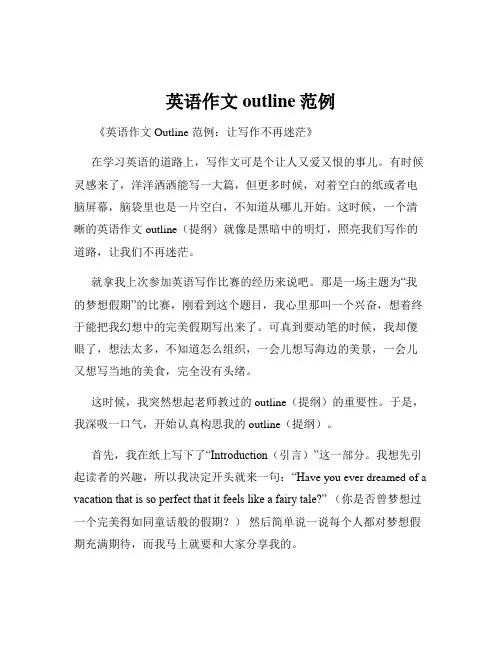
英语作文outline范例《英语作文 Outline 范例:让写作不再迷茫》在学习英语的道路上,写作文可是个让人又爱又恨的事儿。
有时候灵感来了,洋洋洒洒能写一大篇,但更多时候,对着空白的纸或者电脑屏幕,脑袋里也是一片空白,不知道从哪儿开始。
这时候,一个清晰的英语作文 outline(提纲)就像是黑暗中的明灯,照亮我们写作的道路,让我们不再迷茫。
就拿我上次参加英语写作比赛的经历来说吧。
那是一场主题为“我的梦想假期”的比赛,刚看到这个题目,我心里那叫一个兴奋,想着终于能把我幻想中的完美假期写出来了。
可真到要动笔的时候,我却傻眼了,想法太多,不知道怎么组织,一会儿想写海边的美景,一会儿又想写当地的美食,完全没有头绪。
这时候,我突然想起老师教过的outline(提纲)的重要性。
于是,我深吸一口气,开始认真构思我的outline(提纲)。
首先,我在纸上写下了“Introduction(引言)”这一部分。
我想先引起读者的兴趣,所以我决定开头就来一句:“H ave you ever dreamed of a vacation that is so perfect that it feels like a fairy tale?” (你是否曾梦想过一个完美得如同童话般的假期?)然后简单说一说每个人都对梦想假期充满期待,而我马上就要和大家分享我的。
接下来是“Main Body(主体)”。
这可是重头戏,我把它分成了三个段落。
第一段写“Destination(目的地)”,我选的是浪漫的法国巴黎。
我详细描述了我为什么选择巴黎,比如那里有闻名世界的埃菲尔铁塔,充满艺术气息的卢浮宫,还有香榭丽舍大道上的时尚店铺。
我写道:“The Eiffel Tower, standing majestically in the heart of Paris, has always been a symbol of romance and elegance Just imagining standing at its topand looking down at the cityscape makes my heart race with excitement”(埃菲尔铁塔,雄伟地矗立在巴黎的中心,一直是浪漫和优雅的象征。
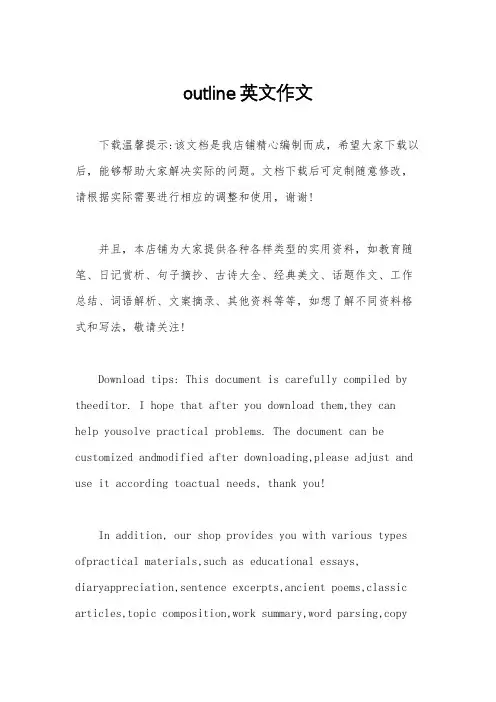
outline英文作文下载温馨提示:该文档是我店铺精心编制而成,希望大家下载以后,能够帮助大家解决实际的问题。
文档下载后可定制随意修改,请根据实际需要进行相应的调整和使用,谢谢!并且,本店铺为大家提供各种各样类型的实用资料,如教育随笔、日记赏析、句子摘抄、古诗大全、经典美文、话题作文、工作总结、词语解析、文案摘录、其他资料等等,如想了解不同资料格式和写法,敬请关注!Download tips: This document is carefully compiled by theeditor. I hope that after you download them,they can help yousolve practical problems. The document can be customized andmodified after downloading,please adjust and use it according toactual needs, thank you!In addition, our shop provides you with various types ofpractical materials,such as educational essays, diaryappreciation,sentence excerpts,ancient poems,classic articles,topic composition,work summary,word parsing,copyexcerpts,other materials and so on,want to know different data formats andwriting methods,please pay attention!I. The morning sun peeked through the curtains, castinga warm glow in the room. I stretched and yawned, feelingthe comfort of my bed and the temptation to stay a little longer.II. As I stumbled into the kitchen, the aroma offreshly brewed coffee filled the air. The first sip sent a jolt of energy through my body, awakening my senses and preparing me for the day ahead.III. The hustle and bustle of the city greeted me as I stepped outside. The honking of cars, the chatter of pedestrians, and the distant hum of the subway created a symphony of urban life.IV. Work was a whirlwind of meetings, emails, and deadlines. The constant buzz of activity kept me on my toes, and I found myself navigating through a sea of tasks and responsibilities.V. Lunchtime provided a brief respite from the chaos. I savored each bite of my meal, allowing myself to pause and recharge before diving back into the afternoon's demands.VI. The evening commute was a mix of exhaustion and anticipation. As I boarded the train, I couldn't help but look forward to the comfort of home and the promise of relaxation.VII. Finally, as I settled into bed, I reflected on the day's events. Despite the challenges and the fatigue, there was a sense of satisfaction in knowing that I had tackled whatever came my way.VIII. With a contented sigh, I closed my eyes and let the tranquility of sleep wash over me, ready to embrace whatever the next day would bring.。
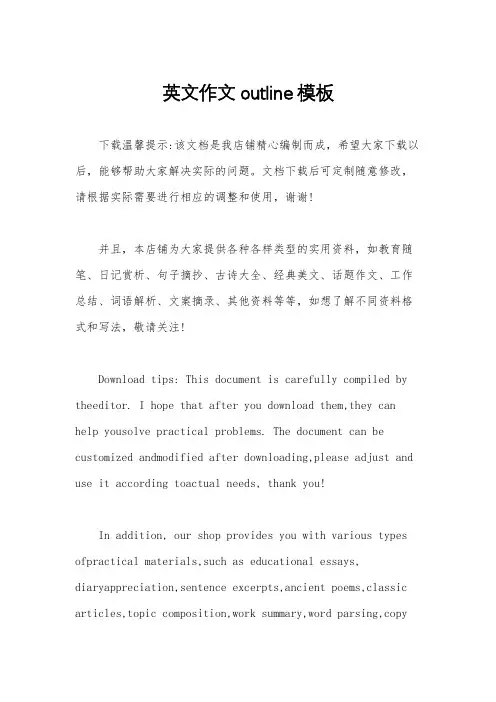
英文作文outline模板下载温馨提示:该文档是我店铺精心编制而成,希望大家下载以后,能够帮助大家解决实际的问题。
文档下载后可定制随意修改,请根据实际需要进行相应的调整和使用,谢谢!并且,本店铺为大家提供各种各样类型的实用资料,如教育随笔、日记赏析、句子摘抄、古诗大全、经典美文、话题作文、工作总结、词语解析、文案摘录、其他资料等等,如想了解不同资料格式和写法,敬请关注!Download tips: This document is carefully compiled by theeditor. I hope that after you download them,they can help yousolve practical problems. The document can be customized andmodified after downloading,please adjust and use it according toactual needs, thank you!In addition, our shop provides you with various types ofpractical materials,such as educational essays, diaryappreciation,sentence excerpts,ancient poems,classic articles,topic composition,work summary,word parsing,copyexcerpts,other materials and so on,want to know different data formats andwriting methods,please pay attention!Paragraph 1: Well, you know, I really like going to the park. It's such a nice place to relax and enjoy the outdoors.Paragraph 2: Oh, and movies! I love watching all kinds of movies. From action to comedy, there's always something good to watch.Paragraph 3: Another thing I enjoy is reading. It can take me to different worlds and make me feel all sorts of emotions.Paragraph 4: And don't even get me started on food. I love trying different cuisines and flavors. It's amazing how many delicious things there are out there.。
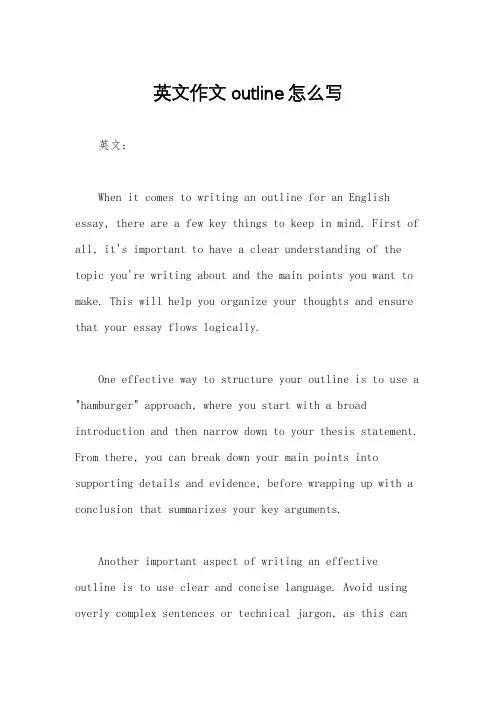
英文作文outline怎么写英文:When it comes to writing an outline for an English essay, there are a few key things to keep in mind. First of all, it's important to have a clear understanding of the topic you're writing about and the main points you want to make. This will help you organize your thoughts and ensure that your essay flows logically.One effective way to structure your outline is to use a "hamburger" approach, where you start with a broad introduction and then narrow down to your thesis statement. From there, you can break down your main points into supporting details and evidence, before wrapping up with a conclusion that summarizes your key arguments.Another important aspect of writing an effectiveoutline is to use clear and concise language. Avoid using overly complex sentences or technical jargon, as this canmake your essay difficult to understand. Instead, focus on using simple, straightforward language that gets your point across clearly.Overall, the key to a successful outline is to be organized, focused, and clear in your writing. By following these tips and taking the time to carefully plan out your essay, you can ensure that your writing is well-structured and effective.中文:在写英语文章的大纲时,有几个关键点需要注意。
outline在css中的用法在CSS中,"outline"属性用于定义元素周围的轮廓线样式。
它通常用于在元素聚焦或被激活时提供视觉反馈。
outline属性有以下常用的属性值和用法:1. `outline-width`:用于定义轮廓线的粗细值。
可以使用像素(px)、em、rem等单位,也可以使用预定义的值(thin、medium、thick)或者用数字表示。
2. `outline-style`:用于定义轮廓线的样式,常见的值包括:dotted(点线)、dashed(虚线)、solid(实线),还有double(双划线)、groove(凹槽线)、ridge(凸槽线)、inset(内嵌线)和outset(外嵌线)等。
3. `outline-color`:用于定义轮廓线的颜色。
可以使用颜色名称、十六进制值、RGB值等方式表示。
4. `outline`:可以将上述三个属性(`outline-width`, `outline-style`, `outline-color`)合并为一个简写属性。
例如:`outline: 1px solid red;`表示轮廓线粗细为1像素、样式为实线、颜色为红色。
以下是一个示例,展示了如何使用outline属性来定义元素的轮廓线样式:```css.outlined-element {outline-width: 2px;outline-style: dashed;outline-color: blue;}```这个CSS代码将会将`.outlined-element`类的元素的轮廓线设置为2像素宽的蓝色虚线。
请注意,`outline`属性不会占据任何空间,因此它不会影响元素的布局。
同时,outline属性与border属性类似,但并不会被包含在元素的尺寸计算中。
希望这能帮助到您!如果您有任何其他问题,请随时提问。
outline详解outline这个属性平时⽤的不太多,最近被问及专门研究⼀下这个属性的作⽤。
CSS2加进来的outline属性,中⽂翻译过来是外轮廓。
神马是轮廓?轮廓,指边缘;物体的外周或图形的外框。
那这样的话外轮廓就是在外部的边框咯。
看⼀下正式的定义:outline (轮廓)是绘制于元素周围的⼀条线,位于边框边缘的外围,可起到突出元素的作⽤。
outline 属性设置元素周围的轮廓线。
看⼀下⽐较实际的体会:在浏览器⾥,当⿏标点击或使⽤Tab键让⼀个链接或者⼀个radio获得焦点的时候,该元素将会被⼀个轮廓虚线框围绕。
这个轮廓虚线框就是outline 。
暂时说完⼤概理解,下⾯继续分析。
CSS2中outline是这样设置的:p{outline-style:dotted;}看起来跟border没有什么区别。
看⼀下⽀持度看起来形势⼀⽚⼤好,不过⽼式的IE6-7貌似不兼容,所以想⽤outline替代border的童鞋可能要失望了。
可能就是这个原因所以平时⽤的⽐较少了。
outline还有⼀个不太常⽤的属性,outline-offset,设置外轮廓相对的偏移量,这⾥的相对可以理解为W3C上⾯标准的盒模型(border之内)div {height: 100px;width: 100px;margin: 50px auto;outline: 10px solid rgba(255,255,0,9);background: black;outline-offset: 10px;border:5px solid blue;}⽐如这样设置之后的效果是这样的黄⾊的是outline,设置了outline-offset之后往外⾯偏移10px,露出了后⾯body的背景⾊红⾊,蓝⾊的是border。
outline与background的关系1<!DOCTYPE html>2<html>34<head>5<meta charset="utf-8">6<title>Examples</title>7<style type="text/css">8 div {9 height: 100px;10 width: 100px;11 margin: 50px auto;12 outline: 10px solid yellow;13 background: gray;14 }1516 body {17 background: red;18 }19</style>20</head>2122<body>23<div>24啦啦啦啦啦啦25</div>26</body>2728</html>View Code结果就是这样的,在body设置类背景⾊红⾊在body⾥⾯的div设置了黄⾊外轮廓⾊,外轮廓⾊在background上⾯。
演讲稿的outline
演讲稿的outline通常由以下几个部分组成:开头、主体和结尾。
下面是一个示例:
一、开头
1. 演讲致辞:对听众表示感谢,介绍自己的身份和背景,引起听众的兴趣。
2. 引入话题:引用一个相关的事实、引语或者故事,引发听众的思考和关注。
二、主体
1. 问题陈述:明确演讲的主题和目的,并简要提出将要讨论的问题。
2. 分类论述:列举几个关键的观点或者论证,按照逻辑顺序扩展和解释它们。
可以使用实例、数据或者专家观点来支持自己的论述。
3. 对话论证:讨论不同观点之间的辩证关系,并以有力的论据和逻辑来辩护自己的立场。
4. 合作共赢:提出解决问题的方法或者建议,并强调共同努力、合作的重要性。
5. 反驳与回应:预测一些可能存在的异议或者批评,并提供有力的回应和反驳。
三、结尾
1. 结论重述:简要总结主体内容,再次强调演讲的主题和目的。
2. 感情激发:采用感人或者激励人心的手法,激发听众的情感共鸣和积极性。
3. 呼吁行动:提出具体的行动呼吁,鼓励听众在日常生活中采取积极的举措。
4. 结束语:对听众再次表示感谢,鼓励他们对演讲内容进行深入思考并与他人
分享。
这里只是一个一般性的演讲稿outline示例,具体的演讲稿内容可以根据主题和目的进行相应的调整和扩展。
outline英文作文下载温馨提示:该文档是我店铺精心编制而成,希望大家下载以后,能够帮助大家解决实际的问题。
文档下载后可定制随意修改,请根据实际需要进行相应的调整和使用,谢谢!并且,本店铺为大家提供各种各样类型的实用资料,如教育随笔、日记赏析、句子摘抄、古诗大全、经典美文、话题作文、工作总结、词语解析、文案摘录、其他资料等等,如想了解不同资料格式和写法,敬请关注!Download tips: This document is carefully compiled by theeditor. I hope that after you download them,they can help yousolve practical problems. The document can be customized andmodified after downloading,please adjust and use it according toactual needs, thank you!In addition, our shop provides you with various types ofpractical materials,such as educational essays, diaryappreciation,sentence excerpts,ancient poems,classic articles,topic composition,work summary,word parsing,copyexcerpts,other materials and so on,want to know different data formats andwriting methods,please pay attention!I woke up this morning feeling exhausted and unmotivated. The weather outside was gloomy, and I just couldn't find the energy to get out of bed.As I stumbled into the kitchen, I realized that I had forgotten to buy coffee the day before. Great, just what I needed – a caffeine-free morning. I grumpily settled for a cup of tea, but it just wasn't the same.On my way to work, I got stuck in traffic for what felt like an eternity. I could feel my frustration building up as the minutes ticked by. I was already running late, and this was the last thing I needed.When I finally got to the office, I was greeted by a mountain of paperwork on my desk. It seemed like my to-do list was never-ending, and I couldn't help but feel overwhelmed.At lunchtime, I decided to take a walk to clear my head. But as soon as I stepped outside, it started pouring rain. Just my luck. I ended up getting drenched and had to spend the rest of the day in soggy clothes.By the time I got home, I was ready to crawl into bed and call it a day. But as I sat down to relax, I received a phone call from a friend inviting me out for dinner.Despite my terrible day, I decided to go and ended uphaving a great time.Reflecting on the day, I realized that even though it started off rough, things took a turn for the better. Itjust goes to show that you never know what the day has in store for you.。
Peer-to-Peer Networks+ an Introduction to JXTA [ECE 451/566] -Introduction to Parallel and Distributed ComputingProfessor: Manish ParasharPresented by Vincent MatossianOn December 12th2005OutlinePart I : Introduction to Peer-to-Peer Computing •Definitions•Challenges•ApplicationsPart II : Project JXTA Overview•Introduction•Architecture•ProtocolsPart I-Introduction to P2P computing -•A peer is a “network individual” that can send, receive, and process messages to and from other peers•A peer-to-peer system is a “network society” where peers exchange messages that fulfill the goals of the network application. For example : File-sharing, Number-crunching, Instant messagingClay Shirky’s “is it P2P ?” test:1)Does it treat variable connectivity andtemporary network addresses as thenorm2)Does it give the nodes at the edges ofthe network significant autonomy?Client/Server : a pictureP2P is commonly contrasted with the client/server model Example:The World Wide Web as we know itPeer-to-Peer : a pictureInstant Messaging (ICQ)File-Sharing (Gnutella)Distributed Computing (Seti@Home)•Shared Resources•BidirectionalCommunicationsHistorical references1970’s till early 1980’sInternet starts off with a P2P architecture (ARPANet)1990’sInternet Architecture and Protocols undergo standardizations (Not truly P2P anymore)Late 1990’s till nowP2P file-sharing applications are the most popularapplications on the InternetP2P overlay networks become testbed for research onfuture Internet“True” Peer-to-Peer• A true peer-to-peer application must implement only peering protocols that do not recognize the concepts of "server" and "client".•Such “true” peer applications and networks are rare. Most networks and applications described as peer-to-peer actually contain or rely on some non-peer elements, such as DNS–DNS is a Name-to-IP mapping system that is basedon a hierarchy of servers contacted for eachtranslation of Name to IPRandom Graph•Random Graph vertices, edges, and connections between them are determined in some random way•Erdos and Rényi(1960) showed that graphs larger than a certain size have a high probability of having that propertyP2P as Random Graph ?•Random graphs follow a Poisson distributionthat a node has degree k : z k e-k/k!–Probability pk•Real networks seem to follow a power-law distribution –Probability of node k having degree k is 1/kP2P and power-law networks •Small World Phenomenon (Stanley Milgram, 1967)–theory that everyone in the world can be reached through a short chain of social acquaintances•Watts and Strogatz define a mathematical model of the phenomenon (1998)–show that the addition of a handful of random links can turn a disconnected network into a highly connected one. •Barabasi defines the WWW as a scale-free network that has small-world properties–Growth:Starting with a small initial number of nodes, in every time step, a new node is added. This new node is connected tom existing nodes.–Preferential Attachment: The probability for a newly added node to be connected to an existing node n depends on thedegree of n(number of connections from n to other nodes). The more connections n has, the more likely new nodes will connect to n.•P2P could align with the WWW vision but it needs to overcome the lack of dynamicityP2P technical challenges •Discovery–How to discover peers, content ?•Messaging and Routing–How to route messages efficiently ?•Metadata/Interoperability–How to encode information for platform independence ?•Quality of Service–How to guarantee levels of service ?•Performance and scalability–How to build a network system that can grow dynamically ?•Security and Trust–How to encode transmission and guarantee privacy of members ?•Accountability–How to police the peergroup ?•Social/Legal Issues–How to avoid infringing international laws (copyright, ownership…) ?P2P application challenges •Administration of peers•Privacy/Anonymity and Security •Trust•Propagation of undesirable content •Intellectual property•Availability of content•Firewall, NAT bypassing•Group membership communicationP2P Benefits•High availability of content •Optimized use of network bandwidth •Lowered cost of content distribution •Leveraged computing power from every node in the network •Unlimited scalabilityP2P Application classes Instant Messaging (ICQ, Jabber, …)File Sharing (Napster-like, Gnutella-like, …)Distributed Search Engines (OpenCola, Copernic, …)Group Collaboration (Groove, NetMeeting, …)Online Gaming Distributed Computing (Seti@Home , Parabon, …)Distributed Storage (Chord, Past, Pastry)Wireless networkWriteable WebLicensed Media Distribution Intelligent AgentWar applicationsT rendCentralized indexes and repositories Central Napster server(x y z.m p 3, 128.1.2.3)128.1.2.3x y z .m p 3 ?128.1.2.3x y z .m p 3 ?Napster163.15.22.45Pros and Cons Cons •Single point of failure •Scalability•Free-riding•Abandoned becauseof legal issues Pros•Performance•Access controlFlooding broadcast of queries Gnutellaxyz.mp3 ?x y z.m p3Pros and ConsPros•True P2P •Legal •Performance in small networks •Scalability •Fault tolerance Cons•Performance in large networks•Security•Free-riding •Reliability •AvailabilitySelective forwarding/routing of queriesClip 2 reflector (Gnutella)Selective forwarding/routing of queries FastTrackNodes become supernodes automatically if they have sufficient bandwidth and processing power.Pros and ConsPros •Performance •Scalability •Fault-Tolerance Cons•Security •Legal issues •State •Free-ridingDecentralized hashing index systems Selective forwarding of queries•Chord•Content-Addressable Networks •Pastry•TapestryN4PublisherClientN6 N9N7N8N3 N2N1Lookup(“sometitle”) Key=“sometitle”Value=MP3 data…ConceptFrom Robert MorrisMITP2P Networks + JXTAChord 1N32N90N105K80K20K5Circular 7-bit ID spaceKey 5Node 105Keys and Nodes share an Identifier space.A key is stored at its successor :node with next higher IDChord 2N32N90N105N60N10N120K80“Where is key 80?”“N90 has K80”Content-Addressable Networks -CAN(K,V)(a,b)retrieve (K)insert(K,V)hash(K) = (a,b)Bootstrapnode 1) Discover some node “I” already in CANnew node CAN Node InsertionI2) pick randompoint in space(p,q)3) I routes to (p,q), discovers node JJ newExample: Octal digits, 218namespace, 005712 Æ627510005712340880943210387510834510727510627510Neighbor Map For “5712” (Octal)Routing Levels1234xxx15712xxx0xxx3xxx4xxx5xxx6xxx7xx025712xx22xx32xx42xx52xx62xx72x012x112x212x312x412x512x61257120712171227123712471257126712771200571201234567340880012345679432100123456783451001234567387510012345677275100123456762751001234567Plaxton-Rajamaran-RichaPastry & TapestryBased on Plaxton Rajamaran Richa algorithm but have additional support for dynamic node insertion and deletion.Node insertion: Node N requests a new ID and contacts a Gateway G. Neighbor map tables are updated along each hop.Minor differences in object replications and routing distances calculation.Comparing Key Metrics•Properties–Parameter–Logical Path Length–Neighbor-state–Routing Overhead–Messages to insert–Mutability–Load-balancing Tapestry Chord CAN PastryLog b N Log2N O(d*N1/d)O(d)Base bbLog b NO(1)ÎO(1)O(1) ?O(1)?App-dep.App-dep Immut.???GoodLog b NLog2NNone Dimen d Base bbLog b N+O(b) O(Log22N)O(d*N1/d)Good Good GoodO(Log b2N)O(Log b N)Designed as P2P IndicesPros and ConsPros •Scalability •Fault-Tolerance Cons•State maintenance •SecurityCommon Applications:•Storage systems•Application-level multicasts •Event NotificationClients Content BrokerContent Distribution NetworksPros and ConsPros •Accessibility •Availability •Load balancing •QoS Cons•Large Infrastructure •Cost•Number of Content brokers depends on demand for a resourceInteroperability and P2POne major problem is that P2P applications are not interoperableA Solution is to have a common set of P2P protocolsPart II : Project JXTAQuote•"Putting things next to each other, which is really what peer-to-peer is about ... having groups of things come into affiliation ... into juxtaposition for a while and then move on."Bill Joy, The O'Reilly Peer-to-Peer Conference, 2001Motivation•Increasing compute power in smaller packages•Pervasive computing is a reality•How should tomorrow’s applications be built to use these available resources ?•What is the right way to approach the problem ?•JXTA presents one effort that tries to answerthese questions (at least the first…)Star Trek Communicator World’sSmallest CellPhoneJXTA defined–What JXTA is Not •Programming language•An application•A library of code–JXTA is a set of open protocolsJXTA: a framework for P2P apps• SUN Introduced JXTA in April 2001 • Motivation is to provide a common platform for P2P development • JXTA defines– Concepts• Peers, peergroups, advertisements, modules, pipes, security– 6 core Protocols• Discovery, Resolver, Information, Endpoint Routing, Rendezvous, Pipe Binding– A Network Architecture• Communication models (unicast, propagate)P2P Networks + JXTAWhat does JXTA enable ?• Find other peers on the network with dynamic discovery across firewalls • Easily share messages and documents with other members across the network • Find content • Create a group of peers that provide a service • Monitor peer activities remotely • Securely communicate with other peers on the networkP2P Networks + JXTAJXTA Peer• Networked device that implements one or more of the JXTA protocols • Operates independently and asynchronously from all other peers • Is uniquely identified by a Peer ID • Publishes network interface as a unique endpoint • Peer endpoints are used by peers to establish direct point-to-point connections between two peersP2P Networks + JXTAJXTA PeerGroup• A group of JXTA Peers • A collection of peers that have agreed upon a common set of services. • Peers self-organize into peergroups, each identified by a unique peer group ID. • Peergroup determines its membership policy • Peers may belong to more than one peergroup simultaneously • Peergroups are meant to create:– secure environment – scoping environment – monitoring environmentP2P Networks + JXTATennisNetworkingWineAdvertisements• Describe all JXTA network resources • Language-neutral metadata structures– Represented as XML documents• JXTA protocols use advertisements to describe and publish the existence of a peer’s resource • JXTA protocols define 8 core advertisements– – – – – – – – Peer Advertisement PeerGroup Advertisement Pipe Advertisement Module Class Advertisement Module Spec Advertisement Module Impl Advertisement Rendezvous Advertisement Peer Info AdvertisementP2P Networks + JXTAModules• Programming design approach • Implement a behavior or functionality • Enable component-oriented programming of an application • Dynamic loading through local or remote provider • The Module abstraction includes– Module Class : the general class or type of behavior – Module Specification : the specific aspect of the behavior – Module Implementation : the actual reference implementationP2P Networks + JXTAPipes• Bill Joy compares them to UNIX pipes • Create a computational flow • Pipes are virtual communication channels that can connect peers that do not have a direct linkpoint-to-point Peer Output Pipe Input Pipepropagate– Point-to-point Pipes – Propagate Pipes – Secure Unicast PipesP2P Networks + JXTASecurity• Five basic security requirements must be provided:– Confidentiality• Content of a message is not disclosed to unauthorized individuals– Authentication• Sender is who he or she claims to be– Authorization• Sender is authorized to send a message– Data integrity• Message was not modified accidentally or deliberately in transit– Refutability• Message transmitted by a properly identified sender and is not a replay of a previously transmitted message• Peers operate in a role-based trust model– Peer acts under the authority granted to it by another trusted peer to perform a particular task• Security provided by– Transport Layer Security protocol – Group Membership enforcementP2P Networks + JXTAMessages• Basic unit of data exchanged between peers • Ordered sequence of named and typed contents called message elements • Message on the wire can be in– Binary format – Text format• JXTA protocols are specified as a set of messages exchanged between peers • For example, a JXTA advertisement is encapsulated within a Message • Each software platform binding describes how a message is converted to and from a native data structure such as a Java object or a C structureP2P Networks + JXTANetwork Services• Peer Service– Accessible only on the peer that is publishing that service.• PeerGroup Services– Offered by multiple members of the peergroup – Can be located, downloaded, and executed dynamicallyP2P Networks + JXTA。